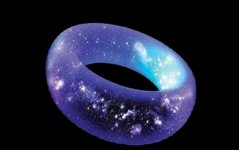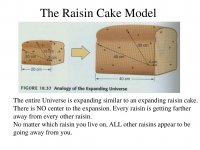in what context/definition is there no center and uniform. You simply cannot have expansion
in every direction without a singularity in a physical realm and the Universe is a physical realm.
If you place two masses sufficiently far apart in space (so their mutual gravitational attraction can be neglected),
we find they recede from each other. If we place a three dimensional array of masses in space far enough apart,
the same thing happens. Just like all the dots on the surface of a balloon recede uniformly from one another
as seen by an observer on one dot as it is blown up, the array of (non-gravitationally bound) masses uniformly
increases in size, with an observer on one mass seeing the same motions as observers on the other masses.
This is what factually happens from our observations. It's up to us to formulate a theory that is consistent
with these observations, if we can. As we have found many times, nature does not have to behave as we expect.
Last edited:
So you're saying this recession is simply a property of matter incidental to the Big Bang? So it's not the Bang itself causing the expansion, it's just a catalyst setting it all in motion? The balloon analogy is a convenient way to discount what's underneath the surface which is never taken to account. Why is that? It's a 2 dimensional analogy to a 3 dimensional reality. How is it factual when it's theoretical? Why are the masses increasing in size when it's Space that is expanding?What observations have been seen to confirm this balloon analogy?If you place two masses sufficiently far apart in space so their mutual gravitational attraction can be neglected,
we find they recede from each other. If we place a three dimensional array of masses in space far enough apart,
the same thing happens. Just like all the dots on the surface of a balloon recede uniformly from one another
as seen by an observer on one dot as it is blown up, the array of (non-gravitationally bound) masses uniformly
increases in size, with an observer on one mass seeing the same motions as observers on the other masses.
This is what factually happens from our observations. It's up to us to formulate a theory that is consistent
with these observations, if we can. As we have found many times, nature does not have to behave as we expect.
So you're saying this recession is simply a property of matter incidental to the Big Bang?The balloon analogy is a convenient way to discount what's underneath the surface which is never taken to account. Why is that? Why are the masses increasing in size when it's Space that is expanding?
The mutual recession shows a property of space, and it is independent of how massive the test masses are;
they could even be protons. The big bang is a theory that is still under construction, but Einstein's theory
does predict this expansion. As you may recall, he first included the cosmological constant in his theory
because without it, the universe was predicted to expand. At that time no one had observed this,
so he adjusted this free parameter in his theory to be nonzero, to prevent the prediction of expansion.
He later called this his greatest blunder.
Observations are considered factual unless and until errors are found, but a theory cannot itself be a fact,
since a theory can never be proven. Observations can be consistent with a theory, but at any time
a new observation could refute the theory. This is how science works; it is science.
Each mass undergoing the mutual recession is itself gravitationally bound together, so the masses
themselves do not expand, and they remain their own size during the expansion. The earth will remain
the same size, the earth's orbit around the sun will remain the same size, and our galaxy (and local group)
will remain the same size, during the expansion. At a certain point gravity overcomes the expansion.
Last edited:
Enter post #2001😎
Sure, if a theory has free parameters, and virtually all do, sometimes it can be adjusted to fit observations.
It is a rare theory that has no free parameters; string theory has none, so it will stand or fall without
the possibility of tweaking.
Last edited:
It's not so much of a ballon as a cupcake - right? There is a mass of doe in which there are raisins. When cocked in a oven (BB), the doe (space) expands but the not the raisins. All raisins inter-distances increases. Space is doe.
QED 🙂
//
QED 🙂
//
He adjusted it to accommodate currently accepted facts.Sure, if a theory has free parameters, and virtually all do, sometimes it can be adjusted to fit observations.
It is a rare theory that has no free parameters; string theory has none, so it will stand or fall without
the possibility of tweaking.
Yes, if you draw black dots on a balloon with a felt tip pen then, as you blow up the balloon, the dots themselves will get bigger as well as the distance between them.It's not so much of a ballon as a cupcake - right?
That is why the 'Raisin Cake Model' is superior, the raisins don't get bigger as the dough expands.
Attachments
The Universe as far as we have been able to fathom is an entity whose behavior is intrinsically mathematical. When Newton was formulating his theories of mechanics, gravitation and motion his insights were facilitated by his and Liebniz's development of the calculus. Einstein's work on the theories of special and general relativity depended on the earlier work of Lorentz on manifolds and Riemann on geometry in more than three dimensions. It is fair to say that progress in physics always depends on concepts from pure mathematics that later turn out to describe fundamental aspects of the Universe.
I don't know about the rest of you but, while I studied the calculus in great depth almost fifty years ago I have no more than a layman's grasp of the mathematics that revealed relativity. So when statements are made here like, "If spacetime started as a singularity there has to be a center" are likely made without insight into the mathematics that underlie the theory we are "discussing". It's analogous to critiquing the writings of Dostoyevskey without understanding the Russian language.
I don't know about the rest of you but, while I studied the calculus in great depth almost fifty years ago I have no more than a layman's grasp of the mathematics that revealed relativity. So when statements are made here like, "If spacetime started as a singularity there has to be a center" are likely made without insight into the mathematics that underlie the theory we are "discussing". It's analogous to critiquing the writings of Dostoyevskey without understanding the Russian language.
He adjusted it to accommodate currently accepted facts.
Yes, but that was a mistake that he always regretted.
There is a mass of doe in which there are raisins. When cocked in a oven (BB), the doe (space)
expands but the not the raisins. All raisins inter-distances increases.
Yes, that's another good analogy. The raisins don't expand, just the dough.
I get the feeling that this discussion, like the universe itself, is going round in circles!
There are actually models of a rotating universe found by Kurt Godel in general relativity.
That is, space itself is rotating, carrying matter along for the ride.
I get the feeling that this discussion, like the universe itself, is going round in circles!
That is diyAudio, man.
Yes of course. But isn't that the nature of this topic?I get the feeling that this discussion, like the universe itself, is going round in circles!
Well if you made the statement you referenced, I'm confident as a layman to declare it would be correct🙂. OTOH, it's difficult to argue with ignorance in a language you don't know.The Universe as far as we have been able to fathom is an entity whose behavior is intrinsically mathematical. When Newton was formulating his theories of mechanics, gravitation and motion his insights were facilitated by his and Liebniz's development of the calculus. Einstein's work on the theories of special and general relativity depended on the earlier work of Lorentz on manifolds and Riemann on geometry in more than three dimensions. It is fair to say that progress in physics always depends on concepts from pure mathematics that later turn out to describe fundamental aspects of the Universe.
I don't know about the rest of you but, while I studied the calculus in great depth almost fifty years ago I have no more than a layman's grasp of the mathematics that revealed relativity. So when statements are made here like, "If spacetime started as a singularity there has to be a center" are likely made without insight into the mathematics that underlie the theory we are "discussing". It's analogous to critiquing the writings of Dostoyevskey without understanding the Russian language.
Okay, the whole mass/area of dough rises and expands simultaneously. So can the mass of matter before the BB be calculated as to how large it was?Yes, that's another good analogy. The raisins don't expand, just the dough.
I can't see how the doe/raisin model inhibits the possibility of a central "explosion" aka "a very small single doe" ...?
//
//
Of course but the contention is that the BB happened "everywhere" all at once, not from a singularity. This is what I have been questioning.
- Status
- Not open for further replies.
- Home
- Member Areas
- The Lounge
- What is the Universe expanding into..


